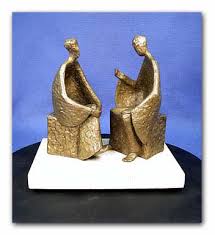
Photo by The Smell of Roses from Pexels.com
I’m Catholic, lesbian, and celibate due to my religious convictions, and I write about those things fairly often, so I’ve seen a fair number of gatherings dealing with the intersection of Christian life and same-sex attraction. And most of those gatherings have been about presenting settled positions. Even where emotional support and intellectual challenge coexisted, they took turns—one presentation would be pastoral and one would be theological, for example. There’s definitely a place for those approaches. And yet for me,a lot of the value of Oriented to Love came from its balance and intermingling of emotional, intellectual, and spiritual work. It was an exploration, rather than a series of presentations, and so while I didn’t come away with one Big Idea, I don’t think finding that big idea was the point.
Instead, here are a few smaller things I think I learned, places where I was helpfully provoked.
The need for healing isn’t always where you might expect it would be.
Most of our conversation was focused on how to live in Christ today, and yet at unexpected moments the past would intrude. People who have been hurt by a culture of sexual permissiveness or religious authoritarianism—or both—can be especially sensitive to anything that seems to defend those values.
It takes a lot of trust for a gay person to describe the specific ways in which she/he was taught to consider her/his perspective unworthy of respect. It takes a lot of trust for people to put aside their assumptions about why someone would accept celibacy. (I was surprised myself at some of the other participants’ self-descriptions!) Several exercises at the retreat were designed to get us past our assumptions about one another and help us trust so that we could share even the more painful aspects of our spiritual lives and our pasts.
It takes a lot of trust for heterosexuals to be truly vulnerable, too. There’s a scene in David Lodge’s novel How Far Can You Go? in which two Catholic characters, spiritual wanderers in the post-Vatican II wilderness, confront one another. One is straight, one is gay, and both have found their sexual desires to be a source of deep conflict and pain. The outside world sees a married man and a stolid monk, two people leading good and normal lives in ordinary religious institutions. And yet they look at each other, with their hearts in turmoil, and think, “You have no idea what it’s like!” There were moments during Oriented to Love where I thought that several of the heterosexual participants were surprised at the ubiquity of certain kinds of pain in gay people’s lives (for example, the frequency of hate crimes)—and there were moments when I was startled when the conversation struck a nerve with some of the “straights.” Sexuality is a site of intense vulnerability, a part of us that is so easy to abuse. A lot of gentleness is needed when we discuss it.
We all need a deeper sense that friendship can be a site of beauty and sacrifice.
It “gets better” if we make it better. I don’t think any of us described growing up in churches where Christian hope was offered, specifically, to same-sex-attracted people. I wasn’t raised Christian; for most of the participants, who were, silence or condemnation was the norm. So I took away from the retreat a desire to speak directly to the next generation.
We talked briefly about Dan Savage’s “It Gets Better” project, which began as a YouTube campaign to create videos in which LGBT adults described how they overcame bullying and homophobia to lead fruitful and fulfilling lives. The project bypasses schools and parents, authority figures who might have little interest in presenting hope or little ability to do so, and speaks directly to the teens who need it the most. I wonder what can be done to present specifically Christian hope to LGBT teens, especially those whose churches, communities, and families are not willing or able to speak to them.
That might look like talking with the counselors at your kid’s school. It might look like donating books to the school or public library—I haven’t found a ton of good books on this subject, but one recent contribution I’d highly recommend is Wesley Hill’s hopeful, personal Washed and Waiting: Reflections on Christian Faithfulness and Homosexuality (Zondervan, 2010). It might look like talking directly with your children, asking what the climate is like in their school for kids perceived as gay, or, if they have openly gay friends, making sure those friends know that your home is a place of welcome. It might look like presenting your testimony at church, on YouTube, to the PTA , or to your young adults’ ministry.
And maybe one thing young people need most of all is to see the Christian church as a place of beauty and a place where suffering is acknowledged and given meaning. All the Scriptural interpretation in the world won’t mean as much, I think, as the longing to be sheltered in Christ’s wounds or tenderly cared for by Christ’s family. LG BT teens need personal testimonies of faithful, joyful, and sacrificial gay Christian life; they also need Oscar Wilde’s fairy tales, Therese of Lisieux’s spiritual fire, the lurid physicality of the Anima Christi, and the tender mysteries of prayer. I took my confirmation name partly as homage to Jean Genet’s novel The Miracle of the Rose, in which a convict’s shackles are transformed into garlands of roses. Do we still believe that the church is where our chains become garlands?
Hope requires a vision of the future.
In Catholic circles you often hear the term “vocations crisis,” referring to the need for new priests. But our entire culture suffers from a vocations crisis: We don’t know how to be adults, how to find and accept the pathways in life which God has set for us. I generally think of vocation as the call to pour out your love for God and for specific other people. Thus priesthood and marriage are vocations, but so too are friendship and service to the poor, among others. Vocation always carries with it specific joys and specific sufferings—a crown and a cross. Vocation is always sacrificial.
Our culture has narrowed the vocations available for heterosexuals down to (delayed) marriage and (optional) childbearing. Friendship is trivialized and service to the poor is professionalized. For LGBT people, Christian communities too often give no vision of vocation at all.
We all need a deeper sense that friendship can be a site of beauty and sacrifice. Christ himself said that there is no greater love than to give one’s life for one’s friends. How much would our own lives change if we believed him? How much would we have to change if we tried to live in sacrificial love for the neediest in our community? Maybe the emergence of gay voices in the church can challenge us to renew or develop vocations outside of marriage—a development that would serve Christians of all sexual orientations.
Eve Tushnet was raised in Washington, DC, where she works as a freelance writer. She was received into the Catholic Church in 1998. She has written for Commonweal, First Things, USA Today, the Washington Blade, the Weekly Standard, and other publications.



One Response